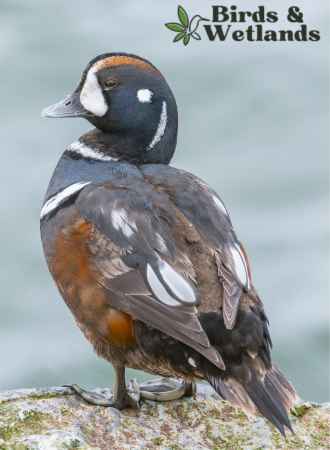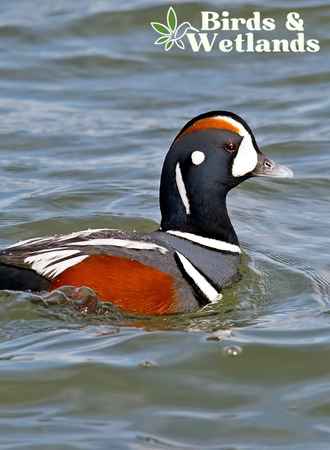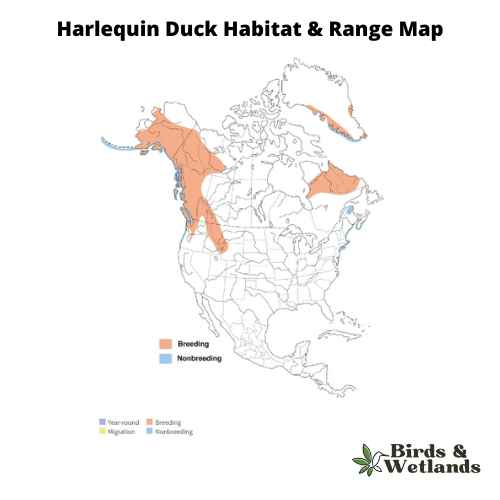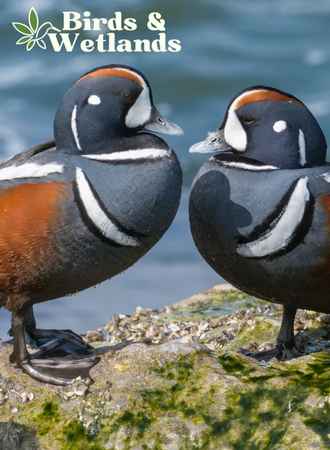The harlequin duck, scientific name Histrionicus histrionicus, takes its name from the iconic character of Harlequin in the Commedia dell’arte, a form of Italian theatre that emerged during the 16th century in Italy. This character was known for his colorful and unique clothing, which made him stand out among the rest of the troupe.
The species’ scientific name is derived from the Latin word ‘histrio’, which means ‘actor’, referring to this theatrical character.
Harlequin ducks are found across North America and Eurasia. They are known as a migratory species, traveling south to coastal areas in winter before returning to breeding grounds throughout North America and Eurasia in the summertime.

Scientific Name: Histrionicus histrionicus
Length: 15–17 in (380–430 mm)
Wingspan: 26 in (660 mm)
Weight: 600 g (1.3 lb)
Harlequin Duck Description
Male Harlequin Ducks
An adult male harlequin duck, in its breeding plumage, is a strikingly beautiful creature due to its colorful and intricate pattern. Its head and neck are a dark slate blue color with a round white spot at each ear. It also has a white crescent-shaped marking in front of the eye, extending up to its crest, and a tiny round dot behind it.
A black crown stripe runs along the top of its head, with chestnut sides contrasting against its lighter slate blue body. A black-bordered white collar adorns this area, separating it from the breast below it, while a vertical black-bordered white bar divides the breast from its sides.
The tail feathers are black and long, forming a pointed tip, while its speculum is metallic blue. The inner secondary feathers are white, creating white markings over the back when folded. The bill is blue-grey, and its eyes are reddish brown.

Female Harlequin Ducks
An adult female harlequin duck has a distinctively dark brown head and neck, with white patches that extend behind and below its eye, reaching up to its forehead. Its body is blackish-brown in color, with the chest and belly more greyish in tone.
Its undertail-coverts are whitish in hue, helping to brighten the otherwise dark plumage. The eyes are the only area of bright coloration, providing a striking contrast against the darker feathers. It has a small bill.
The bare parts of the female’s body are paler than the male harlequin duck, which helps them blend in better with their environment when searching for food or avoiding predators.
Non-breeding & Juveniles
Non-breeding and juvenile male harlequin ducks have a similar appearance to adult females. They have a brownish-grey head and back, white belly and throat. They also have a large white crescent shape on their face and a white stripe that runs down the middle of their back.
Like adult females, they lack the colorful plumage that adult males have during the breeding season. This duller coloring helps to camouflage the birds and protect them from predators.
As the birds mature and reach breeding age, they will develop the colorful plumage of adult males.

Listen to Harlequin Duck
Harlequin Duck Habitat & Geographic Range
The harlequin duck is a species of sea duck that is native to North America and Asia. Its specific habitat includes the coasts of Alaska, the Aleutian Islands, Canada, the northeastern United States, and parts of Russia and Japan.
In the summer, it inhabits rocky coastal areas and fast-flowing rivers, where it is observed to climb steep and slippery rocks easily. The peculiar habit of climbing rocks is one of the reasons why harlequin ducks are more prone to broken bones than other ducks.
These small sea ducks can be found in sheltered bays, rocky shores and estuaries in the winter. These habitats provide the harlequin duck with the food and shelter it needs to thrive.
The harlequin duck is a highly aquatic bird, well-adapted to life in the water, with sturdy legs, webbed feet for swimming, and a streamlined body for efficient movement.

Harlequin Duck Migration
North American Harlequin Ducks are mostly short-distance migrants who travel from inland breeding grounds to nearby coastal areas. This species typically migrates together in small flocks, usually following rivers or coastlines.
Most of their migration occurs between the spring and fall months, as the birds fly southwards in September and October before returning to their nesting sites in April and May.
During this time, harlequin ducks can be seen along the Atlantic Coast from British Columbia south to Georgia or along the Pacific Coast from Alaska south to the Pacific Northwest, Puget Sound, northern California and San Francisco.
They may also travel inland while migrating to reach other wintering destinations, such as lakes or reservoirs where open water is available during cold weather. Harlequin ducks fly low during their annual migrations.
Furthermore, some individuals may remain at their wintering sites year-round due to a lack of suitable inland nesting habitats, resulting in a decrease in population numbers for this species in certain areas.
Harlequin Duck Diet & Food Habits
The harlequin duck’s diet consists primarily of aquatic insects, mollusks, crustaceans, and other small aquatic invertebrates. They feed on many aquatic insects, including mayflies, stoneflies, caddisflies, marine worms, beetles, and mollusks such as snails and clams.
Harlequin ducks have been observed feeding on small fish and crustaceans, such as shrimp, crayfish, and minnows, but these make up a smaller part of their diet.
In general, harlequin ducks are opportunistic feeders and will eat whatever food is available in their habitat.

Harlequin Duck Nesting & Mating Habits
The breeding season starts in May-June, and pairs form in the spring and winter.
Harlequin ducks typically breed and nest near fast-moving streams or rivers, often in a sheltered location such as a crevice in a rock face or a hole in a bank. It rarely builds a nest in a tree cavity.
During the breeding season, the female will lay a clutch of 5-8 eggs, which she will incubate for about a month before they hatch. At this time, the male leaves the female for its usual molting areas.
After hatching, baby harlequin ducks are typically cared for by their mother. In the wild, the mother duck will take on most responsibility for caring for the young ducks.
The mother will lead the ducklings to food sources and help them learn how to forage for food independently. She will also provide them with warmth and shelter and continue to care for them until they are old enough to fend for themselves.

Harlequin Duck Population & Conservation Status
The Harlequin duck’s current population is estimated at 170,000 globally. The species has been designated a low conservation concern with a Continental Concern Score of 12 out of 20.
However, duck wintering populations in eastern North America have declined from historical levels, and the exact cause for this decrease has yet to be discovered. The Washington Department of Fish and Wildlife considers these ducks a priority species.
Climate change and human disturbance, such as logging of their breeding habitat, might be to blame, as it can disrupt stream flow and result in an influx of silt that affects their invertebrate prey.
As coastal species, they are also vulnerable to oil spills and other polluted runoff, which may further threaten them on their breeding and wintering grounds.
As such, their population status remains precarious, and warrants continued monitoring and conservation efforts to ensure their long-term survival.

Harlequin Duck Hunting
The Harlequin duck is considered a game bird in many parts of its range, including the United States. The bird can be hunted in Alaska during the regular waterfowl season, which runs from mid-September to early December.
To hunt this species in other parts of the country, hunters must obtain a special permit. Additionally, waterfowl hunting is subject to regulations and limitations set forth by the state and the U.S. Fish and Wildlife Service.
Hunters prize the Harlequin duck for its meat, regarded as some of the best among all duck species.

Key Points
- The harlequin duck is a small sea duck that breeds in Alaska and Canada.
- The wintering habitat of the harlequin duck is usually along rocky coastlines or rocky shorelines and close to the rapids of mountain streams.
- The male harlequin duck has white stripes, spots and crescents on the head.
- The nest of the harlequin duck is usually a shallow depression on the ground lined with soft plant materials and down. Females rarely nest in tree cavities.


